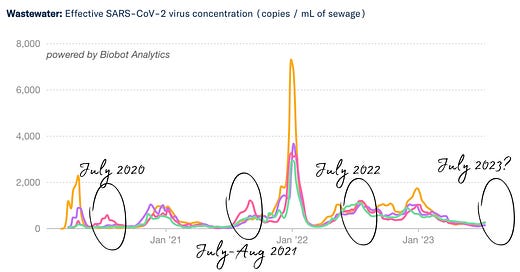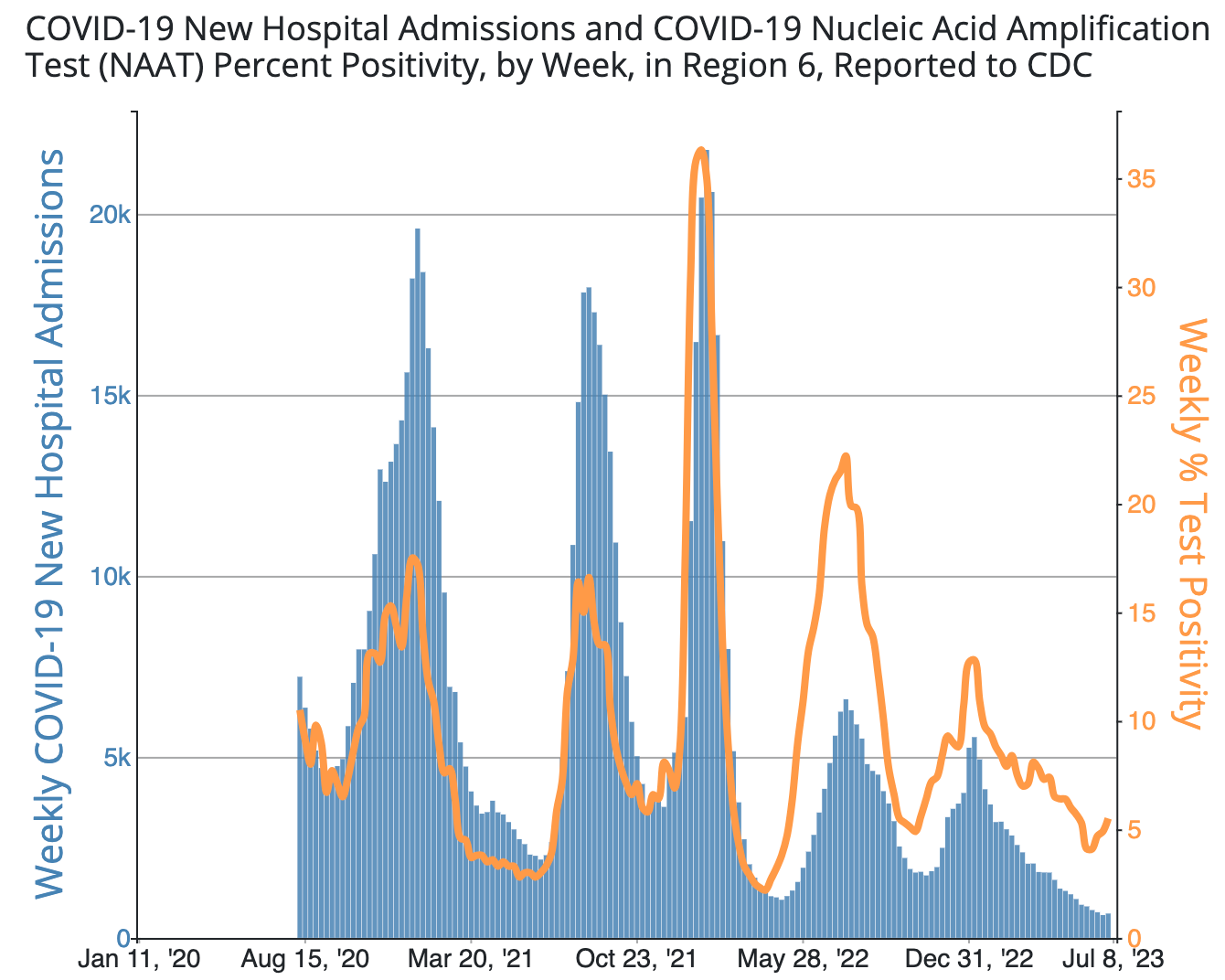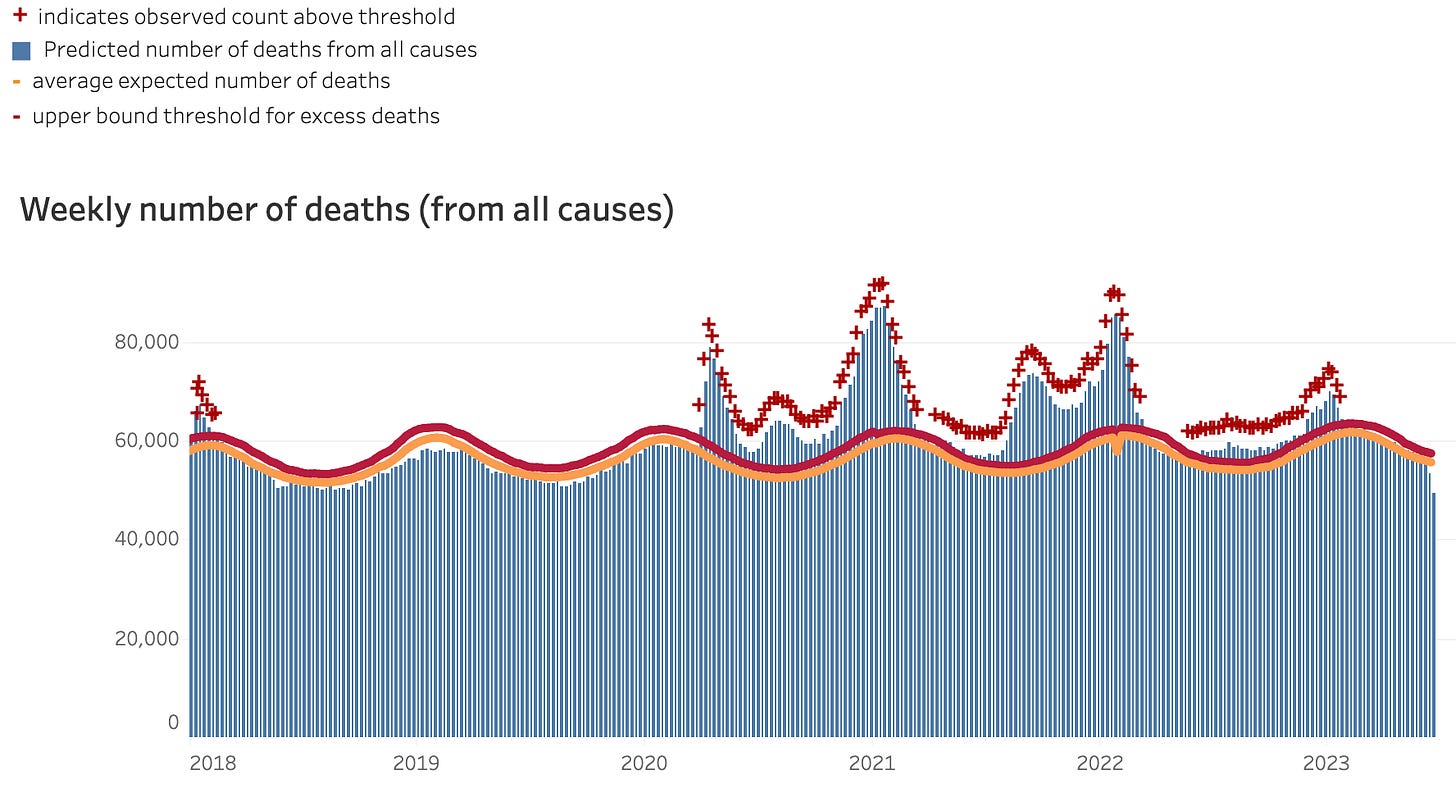Our excellent YLE copy editor is out this week. So, I read and reread this about a thousand times and even downloaded an AI grammar program. I guarantee there are still mistakes. I think we will all live, but consider this your warning.
Yesterday, the New York Times suggested the pandemic is over. We are in a very different place. And, I understand the desire for a “thank goodness that’s done” mindset. And I hope COVID-19 isn’t always on top of your mind.
But COVID-19 is still around. I hope you continue to join me on the scientific discovery ride. Here is your state of affairs.
United States
After a few quiet months, COVID-19 is increasing in the Southern and Western United States. Three early indicators—wastewater, ED visits, and test positivity— are increasing uniformly, albeit from low absolute levels. Using back-of-the-napkin math, this equates to ~1 in 1,180 people infected today. If you squint really hard, hospitalizations are starting to increase, too.
This isn’t surprising; we’ve consistently seen a Southern summer wave throughout the pandemic. While the latest Omicron subvariant soup may partly drive this uptick, it’s more likely behavior; people moving inside due to ridiculous heat.
Since late January 2023, excess deaths have reached pre-pandemic levels. This has been a massive reprieve.
I am surprised; I always assumed that we would need to increase the excess death baseline given we added a new threat to our repertoire. But, for now, we don’t. Perhaps this is due to a combination of things:
You can’t die twice. COVID-19 has killed the most medically fragile people over the last three years, and those premature deaths lead to fewer deaths today. In this case, excess deaths could rebound in coming years;
Population-level immunity. Hybrid immunity is holding up greater than we expected, even among older Americans;
Relative. COVID-19 deaths are so small relative to the entire burden of death that it’s immaterial. It’s a fraction of all daily deaths and within the margin of error;
Another type of death could be decreasing, thus canceling out the impact of COVID-19. (I don’t think this is likely.)
This will be fascinating to follow given the upcoming respiratory season, COVID-19 still settling into seasonality, millions of people losing health insurance, and other things, like the heat wave. I don’t think excess deaths has settled just yet.
International surveillance
Zooming out, eyes are on two particular places around the globe:
Okinawa, Japan. COVID-19 hospitalizations continue to increase exponentially, surpassing their winter wave and overwhelming hospitals. This is driven by XBB, changing behavior (big holiday), and a large pool of susceptible people— it’s been about six months since their last wave. Everyone is waiting to see if this transpires outside of Okinawa.

The average number of COVID-19 patients per medical institution (Okinawa) by week, month, and year. Latest data from July 2. Source: Ministry of Health Dominican Republic: A new Omicron variant— FL1.5.1— is showing its teeth by exponentially increasing quickly. This variant has the same spike protein as what’s currently circulating (XBB) but several non-spike mutations. It’s in its infancy, so it’s unclear if (and how) it will impact real-world metrics. It’s one to keep an eye on.
What’s next?
The COVID-19 Modeling Hub— eight academic teams across the U.S.— just released projections for the next two years: hospitalizations and deaths will likely stay within last year’s range. Unfortunately, this means we should expect to lose 55,000 (optimistic model)- 450,000 Americans (pessimistic model) due to COVID-19.

We’re waiting on a fall vaccine eligibility decision from CDC, which will happen in mid-September. Whispers on the street suggest that everyone will be eligible. The ACIP meeting should be fascinating because we will see the first cost-effectiveness analyses now that vaccines are privatized—are the benefits of the COVID-19 vaccines worth the individual cost for everyone? I would also love to see the updated CDC benefit/risk analysis for young males.
Bottom line
COVID-19 is increasing; don’t be surprised to hear more people getting infected around you. I already am. This isn’t enough reason to change my personal behaviors, but that time may come this fall.
Stay healthy (and cool) out there.
Love, YLE
“Your Local Epidemiologist (YLE)” is written by Dr. Katelyn Jetelina, MPH Ph.D.—an epidemiologist, wife, and mom of two little girls. During the day, she is a senior scientific consultant to several organizations. At night she writes this newsletter. Her main goal is to “translate” the ever-evolving public health world so that people will be well-equipped to make evidence-based decisions. This newsletter is free, thanks to the generous support of fellow YLE community members. To support this effort, subscribe below:








It’s been a long time coming and I should have done this sooner but I wanted to say thank you for your work -- for doing and sharing it so well with all of us. In the last three plus years, trust (in people, institutions, ourselves) has been hard to come by. Thank you for being a beacon of hope that one day reliable, science- based, public health information will be accessible and heard by all. Even if I did not have an immune-compromised child for who we try daily to make the best health and life decisions possible, I would continue reading your updates, thankful for the facts and truth. Thank you.
I was very disappointed in the NYT piece yesterday, and I'm equally disappointed in this posting. We're over three years into this pandemic, and I'm stunned that a post like this does not even mention Long COVID. If we use only one barometer of the risk from a C19 infection (premature death), we are overlooking and minimizing a very important part of the equation. I know people are working hard to erase the pandemic from their memories, and LC is a stubborn and unwelcome reminder that it is still with us. I didn't expect to see that kind of thinking reinforced on these pages.